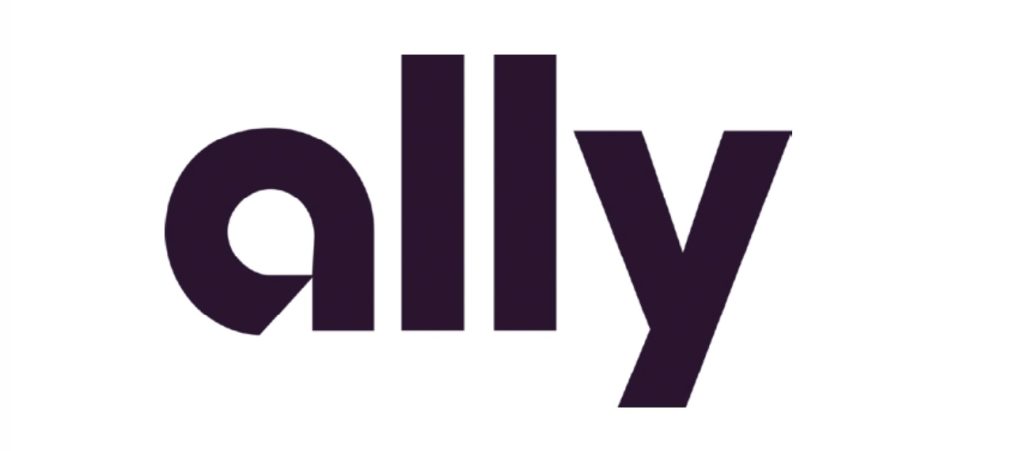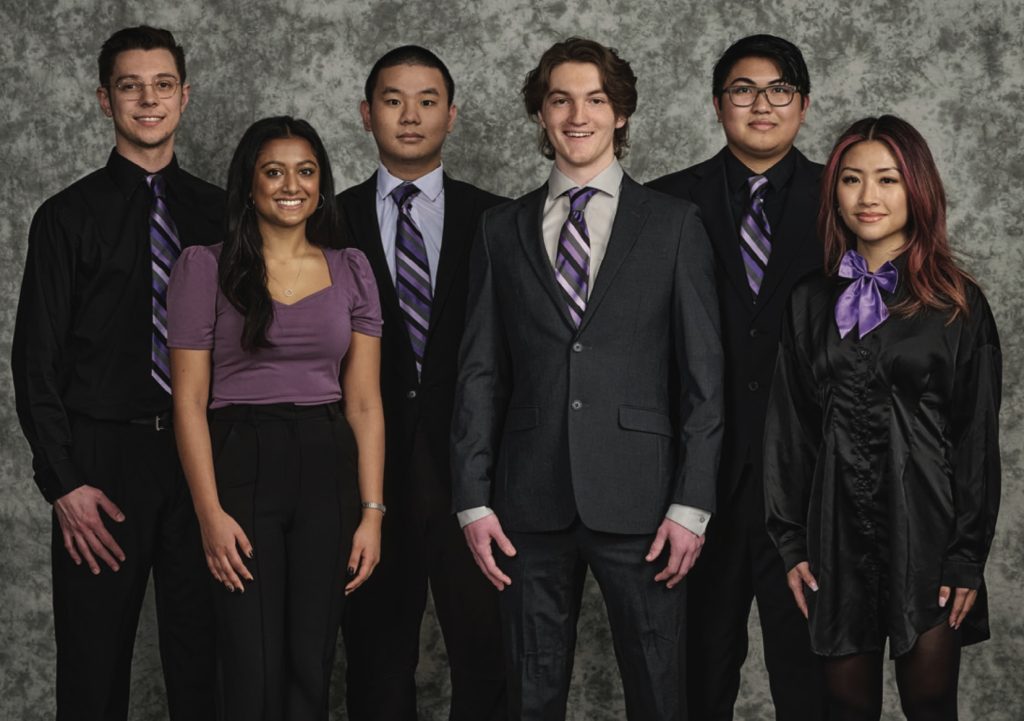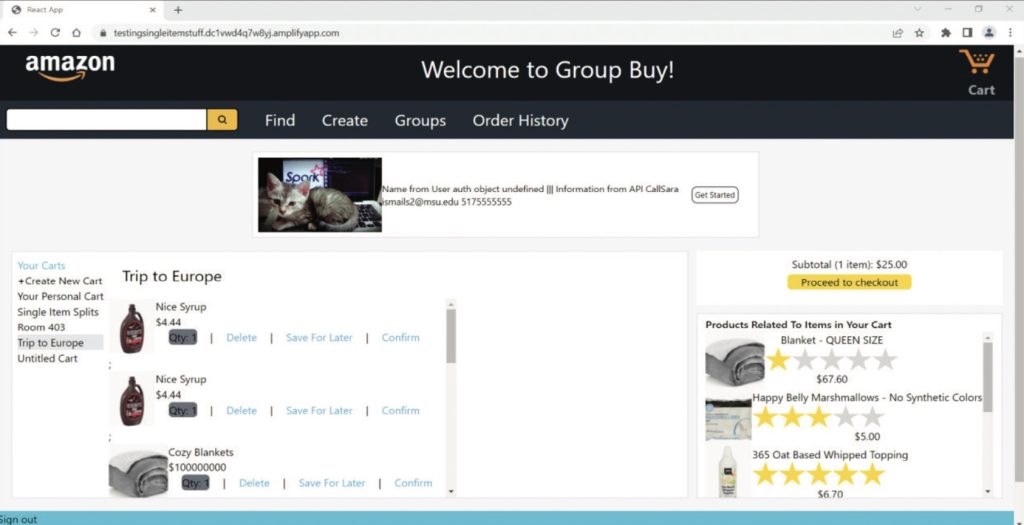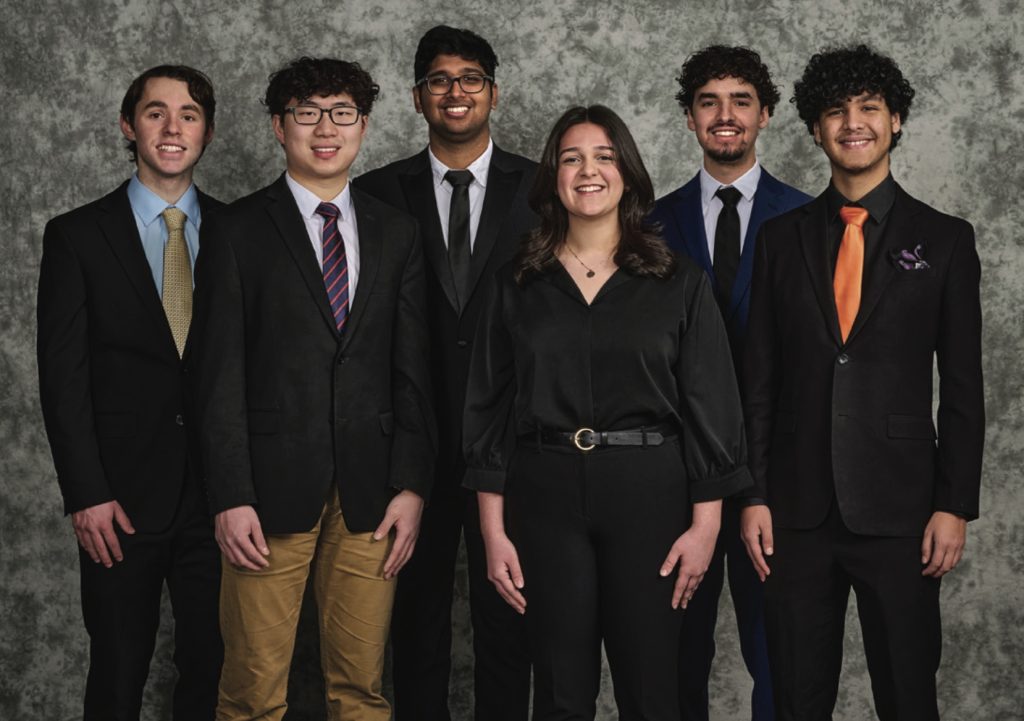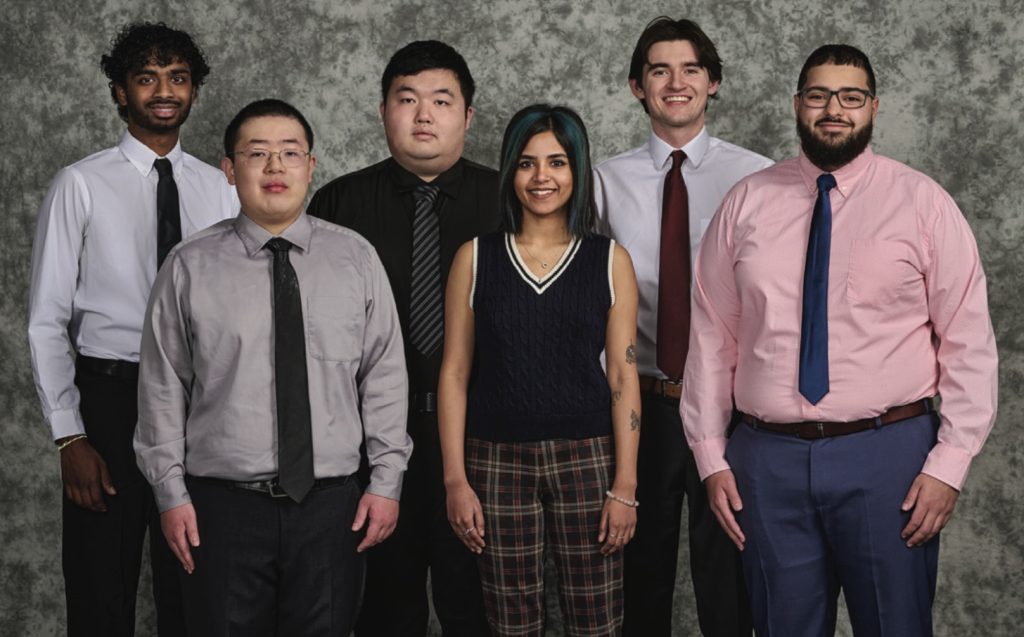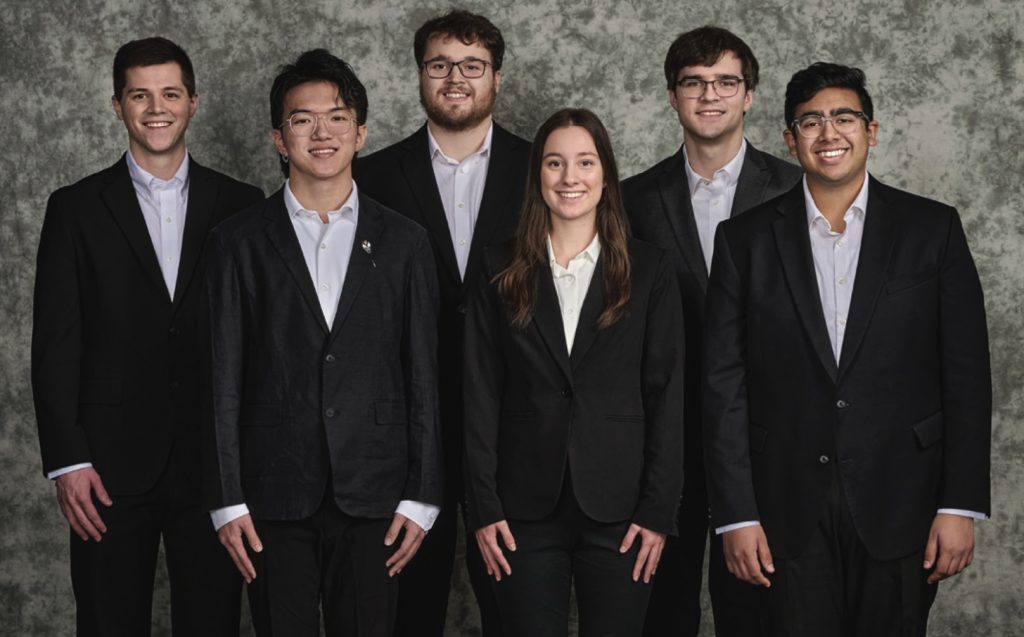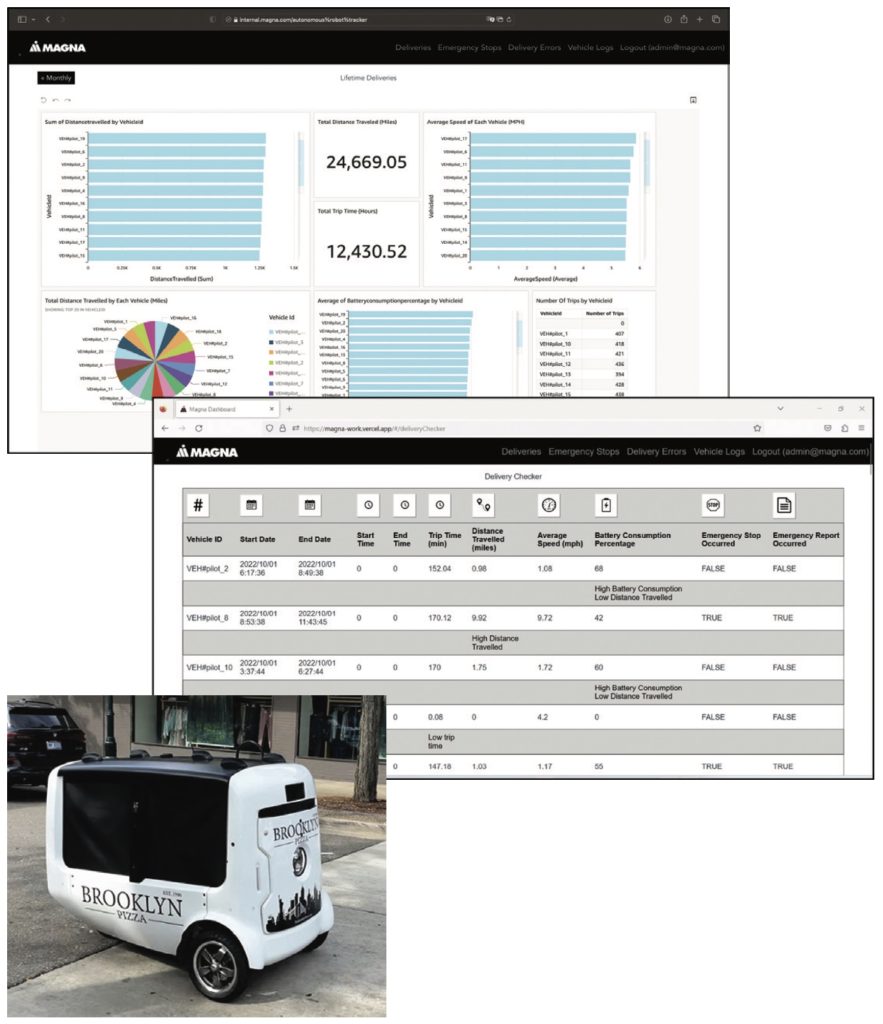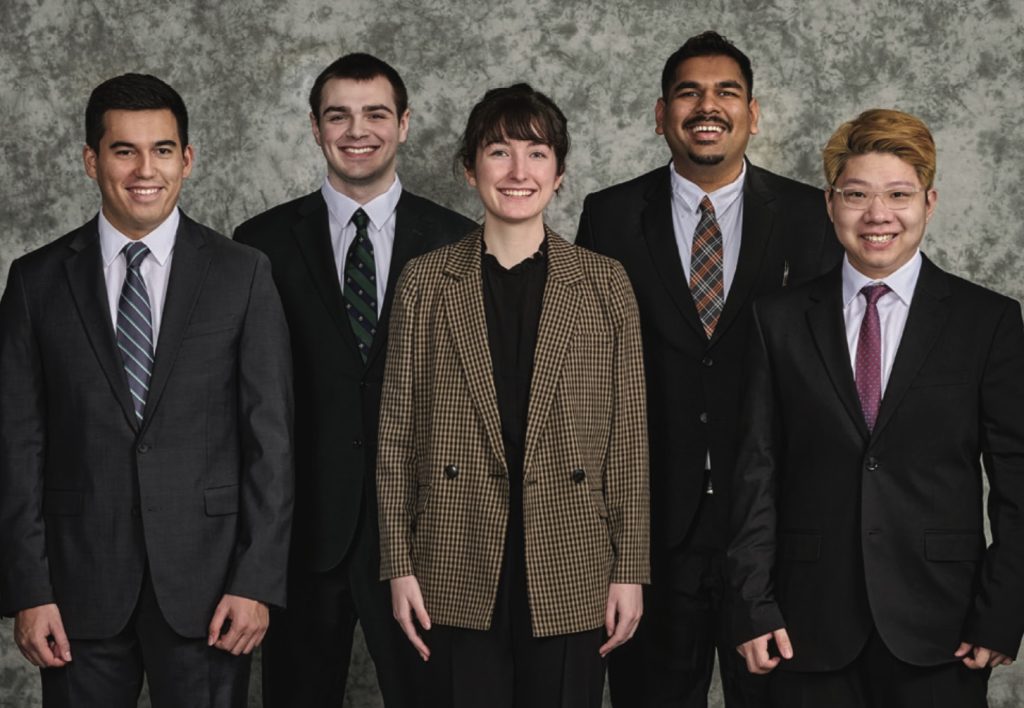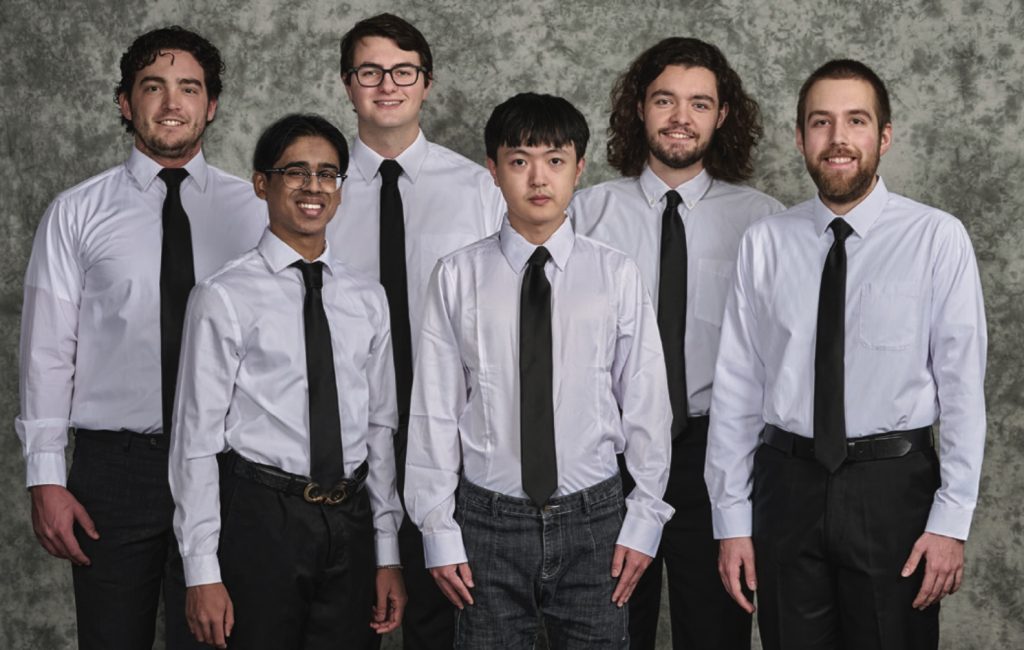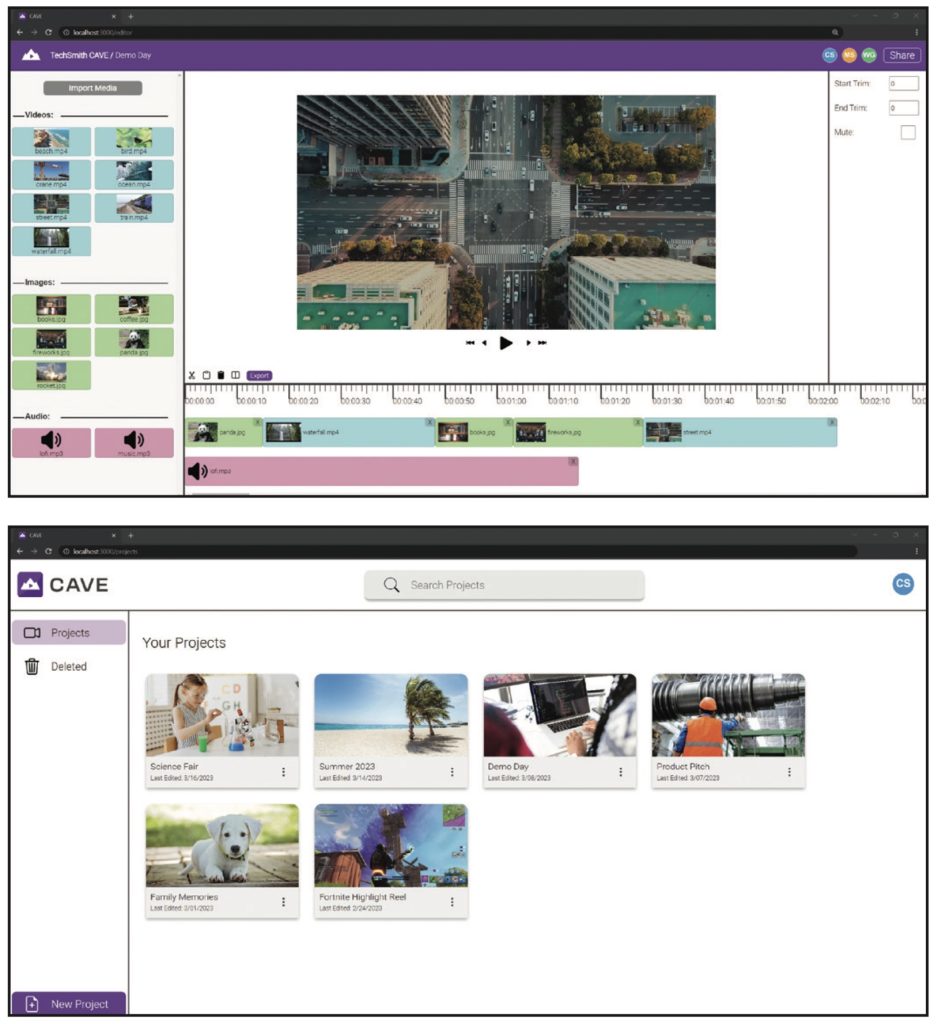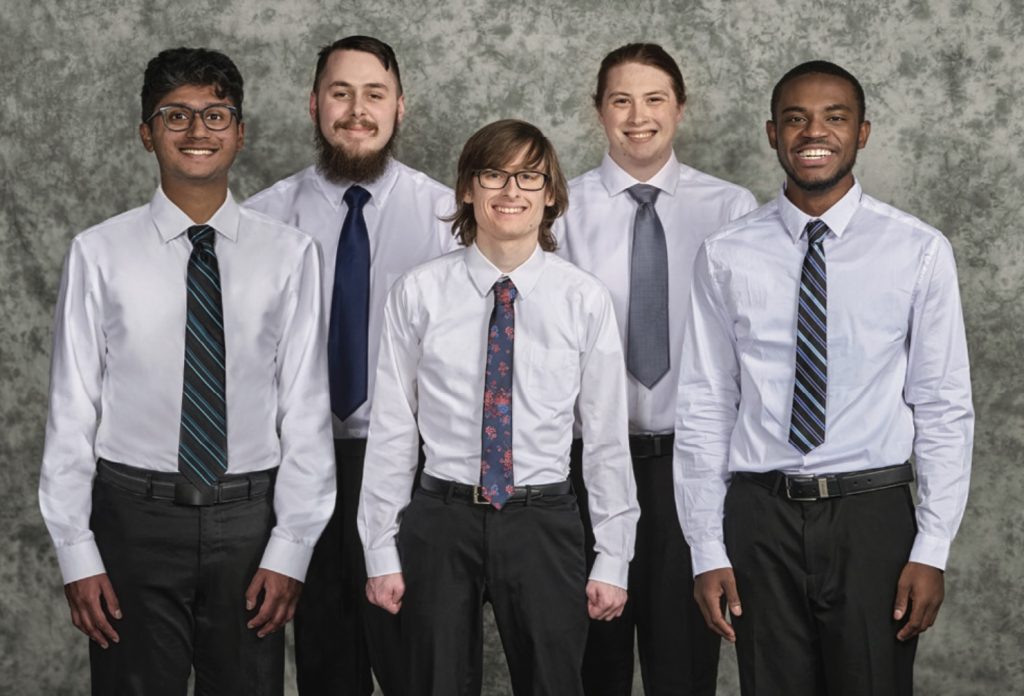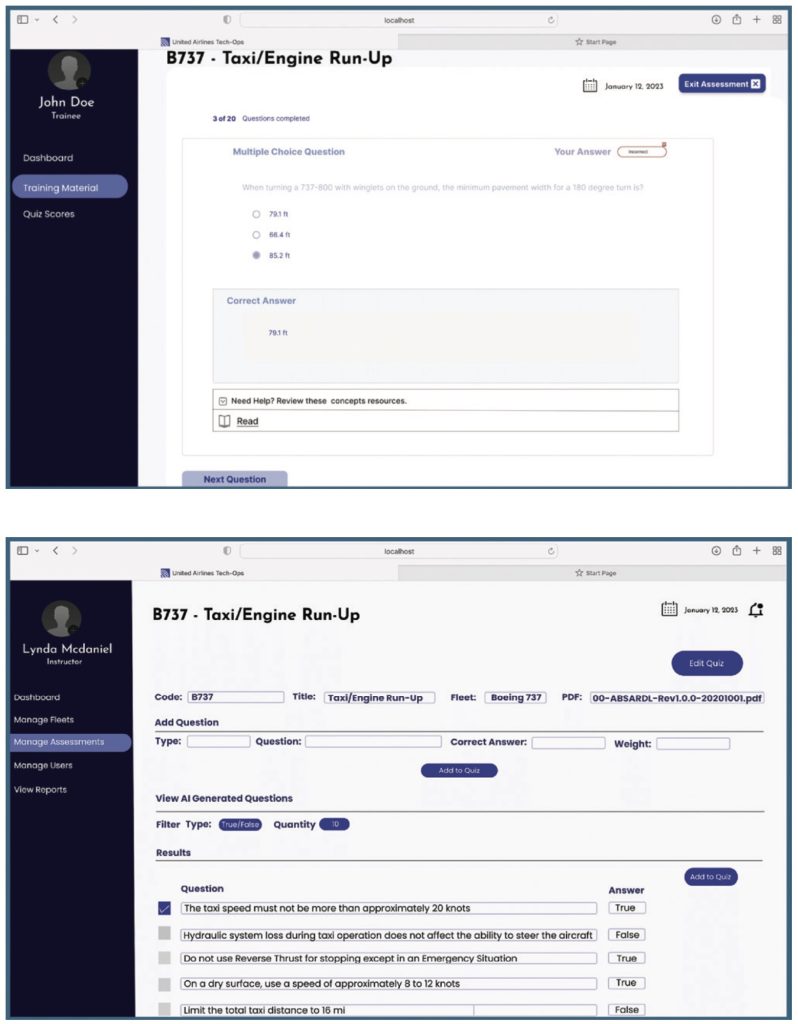Ally Financial: Ally Offers Ecosystem
Amazon: Amazon Group Buying Tool
Anthropocene Institute: Machine Learning for Numeracy Training
Auto-Owners Insurance: The Summarizer
Bosch: Web Interface for CarMaker Simulation Tool
DRIVEN-4: Driven Connect Application, Server, and Backend
Evolutio: #BIKES4ERP Tracking
General Motors: Virtual Reality Network Monitoring
General Motors: Application Lifecycle Framework
Kellogg’s: GHG Scope 3 Automation
Lockheed Martin Space: SmartSat Software Development Kit & AI Platform
Magna: Dashboard for Data Visualization
Meijer: Organization Efficiencies Utilizing WiFi Locationing
Michigan State University: Improved Peer Review in CourseLib
Michigan State University: Build-an-App for Humanities Researchers
Moii AI: Image Similarity System
MSU Federal Credit Union: Predictive Chatbot Experience
Roosevelt Innovations: Provider Analysis Toolkit
Roosevelt Innovations: Model-Driven UI Framework
RPM: Building Shipments using Machine Learning
Targets’ Tip: Documenting Academic Harassment
TechSmith: CAVE Collaborative Audio/Video Editor
Union Pacific: Switch Alignment Mobile Game
United Airlines: Airline Passenger and Baggage Application
United Airlines: Aircraft Appearance Assessment Tool
United Airlines: Adaptive Assessment Generator for Tech Ops Training
Urban Science: OfficeBuddy
Vectorform, LLC: Flexible VR Training
Vectra: Predicting Malware Command and Control Channels
Whirlpool Corporation: SmartCook Smart App for Induction Cooktop Cooking
Ally Financial: Ally Offers Ecosystem
Headquartered in Detroit, Michigan, Ally is a top 25 financial holding company in the United States and a leader in digital financial services. Ally provides financial products for consumers, businesses, automotive dealers, and corporate clients in their commitment to digitalizing and innovating a seamless customer experience. As their name implies, Ally is committed to being an ally to their small business customers.
Ally customers and small businesses use our web application, Ally Offers Ecosystem, to help communities thrive and stay vibrant. Small businesses are often unable to gain traffic in their stores, as well as advertise themselves to a larger audience due to inexperience with technology or lack of a digital platform. Our Ally Offers Ecosystem helps small businesses reach a much broader audience, which in turn, benefits Ally customers too.
The platform gives access to businesses to register and upload their offers on a personalized dashboard. These offers are available to and accessible by all of Ally’s customers. A business can access a personalized dashboard with analytics displaying their performance. Depending on the success of their deals, they can upload, edit, or delete any ongoing offers they would like to advertise to their customers.
Ally customers access a separate dashboard with a multitude of categories of offers to choose from, as well as save their coupons on their profile. Customers can set filters to personalize their interests, which are reflected in a map view of nearby offers. This shows Ally customers appropriate deals and ways to save when visiting businesses partnered with Ally.
Our application is written in HTML, CSS and JavaScript and is powered by the React framework. Our web app interacts with MongoDB and Express to connect to AWS and offers machine learning capabilities.
Michigan State University
Team Members (left to right)
Jered Brophy
Rockford, Michigan
Aesha Ray
Rochester Hills, Michigan
Kainan Chen
Xiamen, Fujian, China
Charles Kellogg
Traverse City, Michigan
Jack Cruz Jr
Zion, Illinois
Winnie Yang
Chicago, Illinois
Ally
Project Sponsors
Jared Allmond
Detroit, Michigan
Dzmitry Dubarau
Charlotte, North Carolina
Dallas Gale
Phoenix, Arizona
Dan Lemont
Detroit, Michigan
Harish Naik
Phoenix, Arizona
Susan Nord
Detroit, Michigan
Arvy Rajasekaran
Charlotte, North Carolina
Kevin Werner
Charlotte, North Carolina
Amazon: Amazon Group Buying Tool
Amazon is a multinational technology company that has grown to become the world’s largest online retailer. Founded in 1994 by Jeff Bezos, Amazon has since expanded into various industries, including cloud computing, digital streaming, and artificial intelligence.
By practicing customer obsession, Amazon delivers products that bring joy and utility to their customers. The company provides shoppers with an intuitive purchasing experience, enabling items to be added to a customer’s cart quickly and seamlessly. Amazon is consistently thinking about different features to enhance their product purchasing process. Currently, customers must utilize third-party services to share expenses, without a way to do so on the Amazon retail website.
Our Amazon Group Buying Tool enhances the shopping experience by enabling users to form groups, initiate purchases with other customers, and share costs among group members. The tool also helps users to search for products and receive product recommendations based on group information and products in their cart.
Our software significantly reduces the time needed to buy items in collaboration with other customers. It also simplifies the process of purchasing items that may be challenging to afford individually, leading to an increase in sales.
The tool also makes donating to organizations easier than ever by giving users a simple method to find and contribute to group wallets. Overall, our tool provides value to a wide variety of people.
The web application is responsive and scalable due to a robust set of Amazon Web Services. The front end is hosted on AWS Amplify and back-end requests are swiftly handled by API Gateway, Lambda, and DynamoDB. Product recommendations are managed by AWS Comprehend.
Michigan State University
Team Members (left to right)
Ryan Conley
Grayslake, Illinois
Sungyu Kwon
West Hartford, Connecticut
Ashrey Gupta
Ludhiana, Punjab, India
Sara Ismail
Novi, Michigan
Rashad Abada
Grand Rapids, Michigan
Zane Aridi
Dexter, Michigan
Amazon
Project Sponsors
Jacob Ackley-Smith
Detroit, Michigan
Zach Arnold
Detroit, Michigan
Tejas Bharath
Detroit, Michigan
Garret Gaw
Detroit, Michigan
Derek Gebhard
Detroit, Michigan
Varun Mantri
Detroit, Michigan
Mitchell Morrell
Detroit, Michigan
Anthropocene Institute: Machine Learning for Numeracy Training
The Anthropocene Institute is an organization that supports researchers, universities, and start-ups in a quest to advance necessary technologies for a better future. Their focus is currently on alleviating the current climate crisis.
In the modern day, critical thinking about numbers is a required skill for success. Being able to make quick, informed judgments with numbers is vital. Topics like government spending, bills, investing, and many more require this skill. However, many people today are currently lacking these abilities.
Our Machine Learning for Numeracy Training software alleviates this issue by educating the public about numeracy with an easy-to-use website that both teaches and challenges users.
The first component of our software is the instructional content, composed of three modules: big numbers, scientific notation, and units of measurement.
Each module holds a set of lessons. These lessons contain text, graphics, and questions that users interact with to master the topics. The user’s progress is saved and viewable from the learn page indicated by progress bars. The user can interact with an AI chatbot for assistance at any time during their learning process.
The second component of our software is the activities. There are two main games offered: metric hangman, and estimates. Metric hangman is a classic game of hangman; however, users input metric prefixes as their guesses, either the literal prefixes or their numerical value. Estimates is a guessing game in which users are prompted with quick questions to answer about a range of topics. Their answers are graded on both speed and accuracy.
The front end of our software is written in HTML and JavaScript. The back end is composed of a mySQL database and Flask for storing and rendering content for games and user information. The software utilizes OpenAI’s GPT-3 API to support the chatbot.
Michigan State University
Team Members (left to right)
Xukai Fang
Hangzhou, Zhejiang, China
Matthew McDerment
Commerce Township, Michigan
Ricky Horan
Chicago, Illinois
Christian Vaughan
Dexter, Michigan
Daniel Passos
Ann Arbor, Michigan
Phumapiwat Chanyutthagorn
Buengkum, Bangkok, Thailand
Anthropocene Institute
Project Sponsors
Melinda Alankar
Palo Alto, California
Frank Ling
Tokyo, Japan
Carl Page
Palo Alto, California
Auto-Owners Insurance: The Summarizer
Auto-Owners Insurance is a Fortune 500 company headquartered in Lansing, Michigan. Auto-Owners is represented by 48,000 licensed insurance agents in 26 states and provides insurance to nearly 3 million policyholders.
As a major insurance agency, Auto-Owners receives thousands of feedback reports, employee surveys and branch audits. These documents provide Auto-Owners general information on how customers and employees view the company.
Currently, Auto-Owners employees manually review and extract key takeaways from these documents, a labor-intensive and time-consuming process.
The Summarizer is a web application that reduces the time needed to review documents by quickly processing them and distilling them down to key components for the user to view.
Users start by uploading a document they want summarized to the web application. Our software then processes the document and displays key metrics such as word frequencies, the overall sentiment of the document, as well as a document summary.
The metrics are displayed in a visually intuitive interface which includes tables, graphs and a word cloud. Users can click between tabs to view the different aspects of the summary report. Administrators can also view summary reports from previously uploaded documents.
Our software cuts down on the time Auto-Owners’ employees spend to understand the feedback they receive and gives them more time to act on it. This gives Auto-Owners the ability to make quick and effective changes so they can continue to deliver excellent service and quality products to their customers.
Our front end of the application is built with HTML, CSS and JavaScript, while the back end is implemented with Python Flask. The data for the application is stored in an SQLite database.
Michigan State University
Team Members (left to right)
Jonathan Kippe
Goodrich, Michigan
Brylee Pavlik
Freeland, Michigan
Tyler White
New Boston, Michigan
Thinh Nguyen
Muskegon, Michigan
Ian Byram
Grand Blanc, Michigan
Jiahui Hu
Beijing, Beijing, China
Auto-Owners
Project Sponsors
Tony Dean
Lansing, Michigan
Ross Hacker
Lansing, Michigan
Scott Lake
Lansing, Michigan
Bosch: Web Interface for CarMaker Simulation Tool
Bosch, founded by Robert Bosch, is a German multinational engineering and technology company headquartered in Gerlingen, Germany. Bosch is a leading global supplier of automotive technology and services, having more than 100 locations all over the world.
Bosch is a world leader in developing solutions for autonomous vehicles, and is on the forefront of creating, prototyping, and testing both hardware and software for these vehicles. Bosch utilizes the CarMaker simulation software to run complex simulations to test autonomous vehicles. However, CarMaker must be run on specialized workstations not present in every office, making it difficult for Bosch staff to use CarMaker on the fly.
Our Web Interface for CarMaker Simulation Tool provides an easier, more efficient way for Bosch engineers to communicate with CarMaker simulators to load, run, and view the results of their simulation without ever having to touch a physical computer or install any software.
Bosch engineers have the ability to load scenarios and vehicle models, change parameters in the scenarios, start and stop simulations, view the simulation status, and download simulation results remotely, utilizing an easy-to-use web application.
Users can select the specific machine they want their simulations to run on, giving the maximum amount of control to engineers so they may further fine tune tests.
Through this application, Bosch engineers can utilize our web application to provide safer and more secure autonomous vehicles in the future.
Our web application is built using SvelteKit, Tailwind CSS, and SQLite. The web application interacts with each of Bosch’s HIL machines through their own instance of a Flask REST API, allowing for control over the CarMaker simulation through HTTP requests.
Michigan State University
Team Members (left to right)
Nicholas Ly
Glendale Heights, Illinois
William Lu
Linyi, Shandong, China
Alhassan Diallo
Detroit, Michigan
Judy Effendi
Troy, Michigan
Tom Ladouceur
Farmington Hills, Michigan
Kevin Meehan
Waterford, Michigan
Bosch
Project Sponsors
Troy McCormick
Plymouth, Michigan
Lucas Ringe
Plymouth, Michigan
Jian Tang
Plymouth, Michigan
DRIVEN-4: Driven Connect Application, Server, and Backend
DRIVEN-4, recently founded in 2016 and headquartered in Saint Joseph, Michigan, provides industry-specific expertise and technological solutions to clients in the areas of Product Lifecycle Management (PLM), connected product development (IoT), connected operations (IIoT), cloud services, and cybersecurity.
Currently, DRIVEN-4 utilizes two core technologies for connected product development and operations: PTC’s ThingWorx and Digi’s Remote Manager. Together, they provide decentralized management and monitoring of remote devices. Users connect their devices to the Internet, monitor device health and storage, manage device firmware, download data from devices, and perform data analytics and visualizations.
As DRIVEN-4 scales up in size, they are developing their own IoT Driven Connect Board that collects data from the device’s sensors. Hosting, interacting with, and storing data from these new boards require a robust and cost-effective solution.
Our Driven Connect Application, Server, and Backend tool solves this issue with a single, streamlined web application. Registered users of an organization connect with their devices over the Internet where they can view and download device data. Users can perform custom data analytics and visualizations on collected data.
Within an organization, administrative accounts manage their users and boards. This includes adding new users, along with updating existing users’ settings, and pushing mass firmware upgrades or downgrades, to any selected boards.
Lastly, DRIVEN-4 server administrators manage all organizations’ users and admins, implement system level settings on devices, push firmware and enable/disable devices.
Our application is built using Python Flask, MySQL databases, and an FTP server for over-the-air firmware updates.
Michigan State University
Team Members (left to right)
Dorian Florescu
Saline, Michigan
Anthony Eid
Troy, Michigan
Ryan Dukovich
Frankenmuth, Michigan
Dongyu Lyu
Shenzhen, Guangdong, China
Tim Nwanze
Ikoyi, Lagos, Nigeria
Jonathan Yamashita
Commerce Township, Michigan
DRIVEN-4
Project Sponsors
Fred Bellio
Saint Joseph, Michigan
Ryan Slaugh
Saint Joseph, Michigan
Carl Wendtland
Saint Joseph, Michigan
Evolutio: #BIKES4ERP Tracking
Evolutio, based in Chicago, brings visibility, simplicity, and usability to complex enterprise platforms. Evolutio and its parent company EPI-USE, are part of the groupelephant.com nonprofit. One part of this nonprofit, #BIKES4ERP, donates bicycles to rural children, mobilizing them to realize their dreams at school.
Unfortunately, there have been cases of these bikes being lost or stolen, with minimal chances of recovery.
Our #BIKES4ERP Tracking tool solves this issue by providing live tracking and alerts for the statuses of bikes through an intuitive web application.
In our tool, admins can add bikes and users of any lower-tiered role to the system. Once added to the system, a bike icon appears on the map on the home page with the color denoting its status.
Teachers with bikes assigned to them by an admin can add a student and pair them with their bike via the system page.
The status of a bike can be updated either automatically or manually. The system marks a bike as possibly stolen if it detects suspicious activity, such as traveling at a high speed or going offline for too long. The status remains as such until manually reverted. All users can make manual status updates to bikes determined by their role. Admins and mechanics can update the status of all bikes in the system, while students and teachers can only change the status of a bike assigned to them.
When a bike is marked as stolen, the assigned teacher and student receive a notification via email and text. The teacher, student, mechanics, and admins are all informed through an alert on the alerts page.
Our system uses TypeScript-based ReactJS for the web page proper. Data communications are received and processed using Amazon Web Services (AWS). The Harness CI/CD software delivery service keeps our system updated.
Michigan State University
Team Members (left to right)
Jason Mih
Kalamazoo, Michigan
Austin Stickney
Williamston, Michigan
Dorian Smalley
Detroit, Michigan
Samantha Kissel
Clarkston, Michigan
Zhilong Feng
Wuhan, Hubei, China
Nick Filerman
Buffalo Grove, Illinois
DRIVEN-4
Project Sponsors
Jordan Cobe
Lansing, Michigan
Jon Dressel
East Lansing, Michigan
Emmanuel Enzenwa
Houston, Texas
Daniella LaGuerre
Washington, D.C.
Jon Rigual
Eau Claire, Wisconsin
Evolutio: #BIKES4ERP Tracking
Evolutio, based in Chicago, brings visibility, simplicity, and usability to complex enterprise platforms. Evolutio and its parent company EPI-USE, are part of the groupelephant.com nonprofit. One part of this nonprofit, #BIKES4ERP, donates bicycles to rural children, mobilizing them to realize their dreams at school.
Unfortunately, there have been cases of these bikes being lost or stolen, with minimal chances of recovery.
Our #BIKES4ERP Tracking tool solves this issue by providing live tracking and alerts for the statuses of bikes through an intuitive web application.
In our tool, admins can add bikes and users of any lower-tiered role to the system. Once added to the system, a bike icon appears on the map on the home page with the color denoting its status.
Teachers with bikes assigned to them by an admin can add a student and pair them with their bike via the system page.
The status of a bike can be updated either automatically or manually. The system marks a bike as possibly stolen if it detects suspicious activity, such as traveling at a high speed or going offline for too long. The status remains as such until manually reverted. All users can make manual status updates to bikes determined by their role. Admins and mechanics can update the status of all bikes in the system, while students and teachers can only change the status of a bike assigned to them.
When a bike is marked as stolen, the assigned teacher and student receive a notification via email and text. The teacher, student, mechanics, and admins are all informed through an alert on the alerts page.
Our system uses TypeScript-based ReactJS for the web page proper. Data communications are received and processed using Amazon Web Services (AWS). The Harness CI/CD software delivery service keeps our system updated.
Michigan State University
Team Members (left to right)
Jason Mih
Kalamazoo, Michigan
Austin Stickney
Williamston, Michigan
Dorian Smalley
Detroit, Michigan
Samantha Kissel
Clarkston, Michigan
Zhilong Feng
Wuhan, Hubei, China
Nick Filerman
Buffalo Grove, Illinois
Evolutio
Project Sponsors
Jordan Cobe
Lansing, Michigan
Jon Dressel
East Lansing, Michigan
Emmanuel Enzenwa
Houston, Texas
Daniella LaGuerre
Washington, D.C.
Jon Rigual
Eau Claire, Wisconsin
General Motors: Virtual Reality Network Monitoring
General Motors (GM) is a global automotive company with an extensive network infrastructure that facilitates communication between its various facilities worldwide. They are the top automaker in the United States.
Managing GM data centers effectively can be challenging due to the size and complexity of their computer network, requiring many systems and analysts to manage.
Our Virtual Reality Network Monitoring tool enables GM employees to monitor their global enterprise network’s physical, logical, and digital traffic flows from anywhere in the world. Our tool provides a more interactive and holistic experience, giving users a better understanding of how data moves within the GM network. With our tool, users can quickly identify infrastructure errors and easily diagnose them.
Our application facilitates user interaction with any GM data center and monitoring of its traffic with three-dimensional virtual visualizations. The tool enables users to select data sites they want to monitor from a menu option, view detailed information about a connection, such as circuits, IP addresses, and packets moving between them, and diagnose issues more comprehensively.
Users can pause the scene, select each individual packet to get more information, and even modify the display brightness, text size, and background color. The experience of using our tool leads to quicker and better network management for GM.
Our application is built on Unreal Engine 5, which processes and displays the data and environment with which the user interacts. Our tool includes the use of both UE5 and C++ for data processing and rendering.
MySQL is used for packet information storage, and WireShark is used to read the packet capture data file, enabling easy exporting of data into various formats.
Michigan State University
Team Members (left to right)
Adam Anderson
Oakland, Michigan
Yilong Xie
Chengdu, Sichuan, China
Nick Wang
Mount Pleasant, Michigan
Keerthi Gogineni
Guntur, Andhra Pradesh, India
Eric Gabbard
Westland, Michigan
Paul Schulte
Livonia, Michigan
GM1
Project Sponsors
Paul Bester
Detroit, Michigan
Brian Chubick
Austin, Texas
Fred Killeen
Detroit, Michigan
Spencer Searle
Detroit, Michigan
General Motors: Application Lifecycle Framework
General Motors is an American automotive manufacturing company headquartered in Detroit, Michigan, and is the top automaker in the United States.
Application distribution is vital at General Motors given the diverse set of engineering and design applications needed during manufacturing. This distribution process is handled in a secure and efficient manner by an Application Lifecycle Framework.
Unfortunately, General Motors’ current application distribution solution is expiring, which necessitates the move to a new solution. The new solution replicates the functionality of the old application but also improves upon the existing process.
Our Application Lifecycle Framework facilitates easy request- submission for applications as well as providing a central hub for status information. It gives administrators, engineers, and testers fine-grained control during the distribution process.
When an employee needs an application on a company device for a work-related task, they submit a request to start the approval process. After submission, an administrator approves or denies the request before assigning a priority as well as an engineer for the next step. Finally, the engineer coordinates with cross-testers and distributors to complete the process. To keep all stakeholders updated, each stage of the process generates a notification.
Our web application features an easy-to-navigate user interface for non-technical personnel as well as an intuitive email notification system to keep users updated at every step of the process. This increases transparency and clarity, reducing internal errors.
For the front end, our application uses Angular, HTML, and CSS. Our system uses a MariaDB server running on Ubuntu for the back end. To communicate between the back end and front end, our application uses Tomcat with Spring Boot to serve HTTP endpoints.
Michigan State University
Team Members (left to right)
Veeresh Rajendran
Kalamazoo, Michigan
Han Zuo
Lansing, Michigan
Muxing Dai
Hefei, Anhui, China
Sneha Sarkar
Al Khuwair, Muscat, Oman
Gram Boyle
Pleasant Ridge, Michigan
Muhammad Huwio
Ypsilanti, Michigan
GM2
Project Sponsors
Gordon Brown II
Detroit, Michigan
Fred Killeen
Detroit, Michigan
Tim Lumley
Detroit, Michigan
Spencer Searle
Detroit, Michigan
Kellogg’s: GHG Scope 3 Automation
Kellogg’s is a Fortune 500 company that operates both domestically and in over 180 international markets. They are most famous for their cereal and snack brands, such as Cheez-It®, Pop-Tarts®, Froot Loops® and Frosted Flakes®.
Kellogg’s is committed to people and their well-being through their Better Days Promise initiative. Kellogg’s plans to reduce 45% of scope 1 and 2 greenhouse gas (GHG) emissions and 15% of scope 3 emissions by 2030. Scope 3 emissions are value chain emissions that include processing of sold products, business travel, waste generated in operations, end-of-life treatment of sold products, etc.
To accomplish their emissions reduction goals, Kellogg’s uses an external agency for which GHG scope 3 data must be collected and analyzed manually due to their complexity. Automating the calculation and creation of easily understood visuals reduces labor costs and reliance on external assessors.
Our GHG Scope 3 Automation tool presents relevant GHG emissions data in the form of charts and graphs in a visually intuitive dashboard accessible by Kellogg’s employees. Kellogg’s employees directly interact with the dashboard to view and analyze the effects of different food products, factories, and vendors. In addition to the dashboard, the GHG Scope 3 Automation website provides users insight on process metrics such as kilograms of greenhouse gas emissions, what ingredients are causing the emissions, and the gases that comprise the emissions.
Our tool helps Kellogg’s automate a process, leading to significant savings in both time and money.
The GHG automation process takes place in the Celonis machine learning workbench. A Python script runs within the Jupyter Notebook to perform calculations and store them. The Flask back end of our website connects to a SQL database with the calculated data. Our JavaScript front end visualizes all of the data.
Michigan State University
Team Members (left to right)
Randy Carnahan
New Baltimore, Michigan
Ayoung Du
Ji’An, Jiangxi, China
Michael Dittman
Casco, Michigan
Lily Albitar
St. Louis, Missouri
Jacob Zawacki
Oxford, Michigan
Shreesha Maddur
Novi, Michigan
Kellogg’s
Project Sponsors
Deanna Adler
Battle Creek, Michigan
Federico Conde
Battle Creek, Michigan
Juan Pablo Cuellar
Querétaro, Mexico
Mackenzee Lamoreaux
Battle Creek, Michigan
Diana Morehouse
Battle Creek, Michigan
Debra Nave
Battle Creek, Michigan
Lockheed Martin Space: SmartSat Software Development Kit & AI Platform
Lockheed Martin Space is a division of Lockheed Martin headquartered in Littleton, Colorado that employs over 16,000 people to build satellite systems and spacecraft.
Satellite operation is being fundamentally reshaped by SmartSatTM, a software-defined satellite architecture developed by Lockheed Martin Space that enables the reprogramming of satellites while in orbit. SmartSatTM also facilitates the use of artificial intelligence onboard satellites to analyze and make decisions from collected data, such as overhead imagery and spacecraft telemetry.
Software development for SmartSatTM is done via software development kits (SDKs) provided by Lockheed Martin Space. Each SDK is a collection of several different development tools that interact with each other. As the variety of hardware supported by SmartSatTM grows, managing the rising number of SDKs becomes cumbersome.
Our SmartSatTM Software Development Kit Manager provides a straightforward way to view, install, modify and publish SDKs for SmartSatTM.
The application displays relevant available SDKs based on the development system and target satellite, as well as currently installed SDKs, in a separate table. Users select an SDK listing to inspect the contents of an SDK or manage its installation status. System administrators publish new, either built from scratch or updated from an existing version, SDKs for download.
Our system’s main component is a command-line utility written in Python Flask that communicates with a MySQL server to store and retrieve SDKs. The front end is a desktop application powered by Electron and written in JavaScript. Onboard an AMD V1000 series APU, inferencing is powered by ONNX Runtime using AMD ROCm for hardware acceleration.
Michigan State University
Team Members (left to right)
Rob Francis IV
Grand Haven, Michigan
Kyle Soderlund
White Lake, Michigan
Maxwell Lu
Grand Rapids, Michigan
Tyler Holt
Concord, Michigan
Kurt LaBlanc
Grand Haven, Michigan
Lockheed Martin Space
Project Sponsors
Josh Davidson
Littleton, Colorado
Joe Epstein
Littleton, Colorado
Brandon Hearn
Littleton, Colorado
Elliott Hoefflin
Littleton, Colorado
Matt Jenkins
Littleton, Colorado
Nicole Saro
Littleton, Colorado
Mark Veyette
Littleton, Colorado
Magna: Dashboard for Data Visualization
Magna International Inc. is a worldwide automotive supplier headquartered in Canada, with their U.S. headquarters in Troy, Michigan. They have been ranked in the Fortune Global 500 for 20 years straight. Magna is the largest automotive parts manufacturer in Canada, and 4th largest in the world.
One of Magna’s goals is reducing last-mile delivery-related emissions in large cities. To this end, they are piloting a program that operates an all-electric fleet of autonomous delivery robots.
Each bot generates countless data points that provide insight into delivery efficiency. Through trip data, Magna can efficiently track fleet performance and make any adjustments that will improve the efficiency of their autonomous delivery fleet.
Our Dashboard for Data Visualization provides a web app for Magna employees to track autonomous delivery data in real time.
Graphs and charts are a vital asset for being able to visualize the information from trips. Within these graphs, employees see various metrics such as battery consumption, distance traveled, trip time, average speed, emergency stop information and more.
All visualizations are updated dynamically as new data is added with respect to the database, providing Magna employees with up-to-date information for analysis of the fleet’s performance.
Using our tool, Magna ensures they are reducing emissions while still providing flawless service to their employees and customers.
Magna stores data in an Amazon Web Service (AWS) storage solution. The data is cleaned with custom AWS Lambdas and delivered to Amazon DynamoDB and then QuickSight. The visualizations created in QuickSight are rendered to Magna’s internal LMDD website using the Vue.js framework.
Michigan State University
Team Members (left to right)
Joey Meng
Troy, Michigan
Augie French
McLean, Virginia
Jannik Eisenlohr
Monheim Am Rhein, North Rhine-Westphalia, Germany
Ria Mokashi
Sterling Heights, Michigan
Suraj Karthikeyan
Singapore
Rondy Gonzalez
Macomb, Michigan
Magna
Project Sponsors
Pranay Jain
Boston, Massachusetts
Adam Naish
Troy, Michigan
Jim Quesenberry
Troy, Michigan
Raidu Rayasam
Boston, Massachusetts
Meijer: Organization Efficiencies Utilizing WiFi Locationing
Meijer is an all-in-one retailer with over 265 locations throughout six midwestern states. Meijer is constantly increasing the efficiency and flow of their stores to improve their offerings and services, and in turn improve customer satisfaction.
One of these systems is Mobile Shop & Scan, available to all Meijer mPerks customers. Shop & Scan enables shopping in-store with the customer’s phone as they place products in the physical cart. Customers may scan items to add them to the mobile cart, clip coupons and promotions, and see the immediate offering value in the Meijer Mobile application.
Our Organization Efficiencies Utilizing WiFi Locationing tool expands the scope of the Shop & Scan process to decrease the checkout time for shoppers. Meijer Mobile shoppers have the option to pay entirely on their mobile device without checking out traditionally.
Our software provides a dashboard that shows the manager of a Meijer location a heat map of where customers in the store are physically located, along with different metrics that can be used to make informed decisions about each employee’s assignment.
Our system makes use of MIST wireless access points located throughout a store that connect to user smartphones to triangulate their location accurately. We pull live data from these access points to make predictions of customer location, as well as locations of customers who might need assistance.
If a customer requires assistance, a Meijer attendant uses our dashboard to locate the customer and perform a Service Check to help the customer quickly resolve any issues they are having.
The consumer mobile app and employee mobile app are built using React Native, while the web app is powered by ReactJS with a Microsoft Power BI dashboard. Each application uses data from an underlying Microsoft SQL database.
Michigan State University
Team Members (left to right)
Haichen Sun
Zhenjiang, Jiangsu, China
Josh Erno
Novi, Michigan
Marv Zurek III
Highland, Michigan
Naveen Kumanan
Chennai, Tamil Nadu, India
Matt Norris
Buchanan, Michigan
Meijer
Project Sponsors
Bill Baer
Grand Rapids, Michigan
Ariel Firon
Grand Rapids, Michigan
Phil Kane
Grand Rapids, Michigan
Terry Ledbetter
Grand Rapids, Michigan
John Morrison
Grand Rapids, Michigan
Samuel Ramos
Grand Rapids, Michigan
Mark Szymanski
Grand Rapids, Michigan
Michigan State University: Improved Peer Review in CourseLib
The Michigan State University Department of Computer Science and Engineering leads several state-of-the-art graduate and undergraduate programs for more than 1,700 students. The department is committed to providing a high-quality educational experience to all of its students.
The Department of Computer Science and Engineering keeps up with growing interest by maintaining a high level of adaptability. This is achieved via CourseLib, a system of components used to create course websites. CourseLib facilitates learning through detail-oriented instruction and hands-on activities.
CourseLib’s peer review system enables students to improve upon industry-valuable skills such as giving informative critiques of someone else’s work, accepting feedback from others, and turning feedback into impactful improvements. The peer review system within CourseLib, while effective, has areas for improvement.
Our improvements to the CourseLib peer review system make it easier than ever for students to receive feedback on their work. Reviewers and reviewees can now have a real-time dialog with one another, making crucial communication easier than ever before.
The feedback process is enhanced through the addition of submission image annotation, allowing users to know exactly where they can make improvements. The new submission association feature makes clear which submission is being discussed. The email notification system is redesigned to effectively provide notifications in all circumstances. Instructors can now reassign individual reviewer- reviewee pairings. Finally, instructors are now notified when students submit and have not been assigned a peer review assignment.
CourseLib uses a JavaScript front end using Vue for a responsive interface and webpack for bundling. CourseLib’s back end is built using PHP and SQL.
Michigan State University
Team Members (left to right)
Dean Eggenberger
West Bloomfield, Michigan
Santiago Rodriguez-Papa
Montevideo, Montevideo, Uruguay
Justin Henkelman
Hudsonville, Michigan
Kishore Sirigiri
Novi, Michigan
Max Brombach
Almont, Michigan
Zhuofan Zeng
Changsha, Hunan Province, China
MSU CSE
Project Sponsors
Charles Owen
East Lansing, Michigan
Michigan State University: Build-an-App for Humanities Researchers
The Michigan State University Linguistics Department formed the MI Diaries team in 2020 in response to the COVID-19 pandemic. Using the MI Diaries app, the team collects and analyzes audio data to understand how people’s lives and language change over time.
The MI Diaries app is an audio recording app that collects audio remotely to use in research studies. This app provides a user-friendly interface that can be used by people of all ages and technical abilities. The app collects audio data, stores it in a database, and provides basic statistics for participants.
The MI Diaries team wishes to expand the reach of their app and allow researchers from across the world to utilize its audio recording capabilities. These researchers often do not have the tools necessary to collect audio data and want to focus on their study objectives instead of the technical details of building an app.
Our Build-an-App for Humanities Researchers provides an easy way to customize the MI Diaries base app without having to touch a line of code. Researchers with minimal technical experience can produce a feature- complete and fully customized long-form audio recording app that is ready to use in their studies.
The App-Builder supports full customization of the colors, logos, and fonts, while also supporting gamification stat screens. The app can be configured to allow sign-up in-app or through an external form. While the main functionality of the app remains the same, users can create a uniquely styled app for their research.
Our solution provides an easy way for researchers to create applications tailor-made for their data collection, saving time and resources over building from scratch.
The main MI Diaries app is built using Flutter to provide a cross- platform app and can be connected to any back-end server.
The front end of our App-Builder is built using Angular 15, while the back end is implemented using Python Flask.
Michigan State University
Team Members (left to right)
Daniel Magaway
Lansing, Michigan
Albert Crooks IV
Harrison Township, Michigan
Tess Coleman
Birmingham, Michigan
Hemkesh Agrawal
New Delhi, New Delhi, India
Shiyu Yan
Guangzhou, Guangdong, China
MSU Linguistics
Project Sponsors
Betsy Sneller
East Lansing, Michigan
Suzanne Evans Wagner
East Lansing, Michigan
Russ Werner
East Lansing, Michigan
Moii AI: Image Similarity System
Moii AI is a multinational MSU-born startup founded in 2019 in Troy, Michigan and Chennai, India. Moii provides real-time alerts and video feed analysis using state-of-the- art artificial intelligence technologies to increase ergonomic flow and improve home security.
Object detection requires artificial intelligence that is trained for detecting specific objects of interest. Moii currently has a system that is able to very accurately detect a limited number of objects. To expand the usability of this system, Moii is focusing on a robust system to detect many more objects at the same time.
Our Image Similarity System makes searching for any type of object within Moii’s expansive image database possible. A large problem is collecting enough images of a particular object to be able to detect the object reliably.
To this end, users start by uploading images and drawing boxes around the object of interest. Our software then uses machine learning to scan through hours of video footage to find images of similar objects, to provide more examples and, in turn, improve Moii’s object recognition.
New images of an object are displayed on a separate page along with the original images and a score indicating how similar the found object is to the object of interest.
Using our system, Moii can quickly determine if a person or object appears in their footage with high accuracy and low cost. Using this software, Moii can more accurately inform their clients about their business and create a more secure environment.
Our system uses Google Cloud Storage to handle transfer of images, Firebase Realtime Database to sync between our front end built on React and the back end, and Google Cloud Platform to host our model. Based off a proprietary machine learning model from Moii, our PyTorch model is trained for deep template matching.
Michigan State University
Team Members (left to right)
Joseph Pallipadan
Thrissur, Kerala, India
Ethan Yang
Okemos, Michigan
Alex Day
Saginaw, Michigan
Hunter Samoy
Romeoville, Illinois
Michael Yin
Shanghai, Shanghai, China
Thalia Sakowicz
Naperville, Illinois
Moii
Project Sponsors
Lakshman Balasubramaniam
Ingolstadt, Bavaria, Germany
Madhu Posani
Troy, Michigan
Deepak Upadya
Troy, Michigan
MSU Federal Credit Union: Predictive Chatbot Experience
Established in 1937, MSU Federal Credit Union (MSUFCU) has been serving Michigan State University and the greater Lansing area for over 86 years. With over 20 branch locations statewide, 335,000 members worldwide, and managing nearly $7 billion in assets, MSUFCU strives to help its local communities thrive and achieve financial freedom.
MSUFCU offers a robust digital banking experience for members to check their balances, transfer funds, and manage all aspects of their accounts virtually. Providing exceptional banking tools is something MSUFCU already does, but they are now focusing on tools to assist members with their finances.
Our Predictive Chatbot Experience turns Fran, the MSUFCU chatbot, into a more informative and useful tool for members. Fran analyzes members’ history and provides supportive financial assistance. Looking at users’ accounts, our version of Fran can identify low points in their accounts, suggest when to pay bills to avoid overdraft fees, and schedule recurring bills.
For example, if a member regularly pays a bill on the 10th and Fran recognizes that the balance is low on that day, she instead suggests the member wait to pay the bill until after their payday on the 13th.
Members also can set spending goals and track them over the month, as well as request a breakdown by category of the spending in a month.
Our application is web-based and written in HTML with JavaScript and CSS. It connects to Boost.AI’s chat panel and a remotely hosted MySQL database. The chatbot’s logic is done in Boost.AI’s low code management platform is used to train the artificial intelligence.
Michigan State University
Team Members (left to right)
Will Kelly III
Detroit, Michigan
Rikito Takai
Novi, Michigan
Nick Wallace
Grand Blanc, Michigan
Lexi Case
Lake Angelus, Michigan
Kaezar Leonard
Detroit, Michigan
Yu Chen
Fuzhou, Fujian, China
MSUFCU
Project Sponsors
April Clobes
East Lansing, Michigan
Filip Danielewicz
East Lansing, Michigan
Maria Hewitt
East Lansing, Michigan
Ben Maxim
East Lansing, Michigan
Meredith Nicholoff
East Lansing, Michigan
Roosevelt Innovations: Provider Analysis Toolkit
Roosevelt Innovations, LLC is the first technology solution to deliver a simple, seamless, and smart platform for health insurance companies. With industry-leading claims processing capabilities, Roosevelt has transformed operations, enabling a total treatment cost savings of $972 million. Additionally, Roosevelt has more than 22 million users on its platform and an industry-leading auto- adjudication rate of 95%.
When processing many insurance claims, there is a large amount of data generated. Data that is anomalous for any reason is cause for further investigation.
Our Provider Analysis Toolkit gives data analysts of Roosevelt Innovations a streamlined, efficient, and verbose view of the data that comes from processing claims. Users can view real-time data, exchange their thoughts with other analysts on specific data, and share reports with other analysts.
Our solution identifies statistical anomalies within the data that can help them further investigate the causes for these anomalies. Data is filtered for the analysts so that the most anomalous data is easily accessible to them in a simple, quick, and efficient manner, requiring no further mathematical calculations on the analysts’ end.
Data visualizations are also provided. Whether the data is represented in tables or charts, everything is laid out in a way that is streamlined and easily digestible.
Our solution automatically flags anomalous data and provides a suite of tools for further analysis, increasing productivity of analysts.
The web application is written in Python with utilization of the Streamlit library for the front-end framework, as well as FastAPI are used for construction of the web application’s APIs. The anomaly detection machine learning models were developed using the PyTorch framework and scikit-learn library, while the data is stored within a Snowflake database.
Michigan State University
Team Members (left to right)
Michael Stanley
Addison, Michigan
Kirsten Gross
Canton, Michigan
Marshall Kroske
Birmingham, Michigan
Rajaditya Bajaj
Yavatmal, Maharashtra, India
Zhenhao Zhao
Taixing, Jiangsu, China
Anna Parkinson
Clarklake, Michigan
Roosevelt Innovations Data Science
Project Sponsors
Mukundan Agaram
Okemos, Michigan
Jessica Black
Okemos, Michigan
Jacob Ernst
Okemos, Michigan
Toby Hall
Okemos, Michigan
Shikha Mohindra
Okemos, Michigan
Ayush Singh
Okemos, Michigan
Abhinav Thirupathi
Okemos, Michigan
Roosevelt Innovations: Model-Driven UI Framework
Roosevelt Innovations, headquartered in Okemos, Michigan, is a software solutions company owned by Delta Dental of Michigan. Its software solutions include customizable data services, customer portals, billing services, and industry-leading claims auto-adjudication. Roosevelt Innovations extends its services to several insurance companies across the country. Altogether, Roosevelt Innovations has over 22 million users on its platforms.
At Roosevelt Innovations, many different user interfaces are developed for insurance companies and their customers. Each new user interface is developed from scratch. This process can be very time-consuming, often requiring hours of effort from developers.
Our Model-Driven UI Framework streamlines the process of designing and building a website, creating dynamic and complex user interfaces with ease.
Our framework documents strategies and formats for creating the skeleton of a form. Once that skeleton is created, it is read by the web application and the form is displayed on the screen. Users can interact with this form and populate the data fields. Upon completing the form, users click on the submit button, at which point the entered data is validated and saved.
In addition to quicker build times, the developers can use the framework to easily create complex forms. The framework contains guidelines for validating user-entered data as well as a structure for creating fields that appear conditionally, making it very versatile. The same system can be used to create many highly customized forms specific to each customer’s needs.
The framework expands upon JSON with custom keywords allowing for additional validation and manipulation of elements. The front end is built using Angular reactive forms to dynamically draw form elements on the webpage. The back end uses Quarkus to process objects and requests from the front end.
Michigan State University
Team Members (left to right)
Ben Lynch
La Grange, Illinois
Naffy Nihal
Roseville, Michigan
Cole Coughlin
Grand Rapids, Michigan
Yuqi Pan
Harbin, Heilongjiang Province, China
Drew Hubble
Okemos, Michigan
Alex Hettle
Rochester, Michigan
Roosevelt Innovations Knowledge Science
Project Sponsors
Mukundan Agaram
Okemos, Michigan
Will Cicola
Okemos, Michigan
Jacob Ernst
Okemos, Michigan
Chang Liu
Okemos, Michigan
RPM: Building Shipments using Machine Learning
RPM is an international logistics corporation which specializes in end-to-end transportation of freight and automobiles. On a monthly basis, RPM’s carriers deliver 50,000 automobiles and 15,000 freight shipments. The company’s headquarters are in Royal Oak, Michigan, and Amsterdam, Netherlands.
The logistics involved in the automotive industry are complex and shipments need to fit to customer specifications while adhering to carrier restrictions. Curating shipments using machine learning takes every specification into consideration.
Our Building Shipments using Machine Learning web application organizes shipping orders based on features and pick- up/drop-off locations to create shipment schedules with the fewest possible stops. It also suggests the best carrier for such shipments to optimize the shipping process.
New orders are input by RPM through CSV or manual data entry, finally being verified by the user to ensure the shipping information is correct.
The process considers the VIN for each individual vehicle, make, model, and all the different vehicle specifications to organize orders and create optimized shipments. An optimized shipment has the least amount of stops and shortest route while also keeping trucks full. This improves the utilization of shipments and improves delivery time.
Our software uses various methods for creating shipments and suggesting carrier vehicle types that users can compare to select what fits their needs the best. We also provide tools for users to analyze and make necessary changes to their shipments.
Our system is built on .NET for front end development and Microsoft Azure for back-end tools and databases. Python’s scikit- learn library is used to develop machine learning models to optimize shipments through clustering.
Michigan State University
Team Members (left to right)
Yanjia Zhu
Nanchang, Jiangxi, China
Ian Berriel
Lake Orion, Michigan
Nicholas Klein
Lakewood Ranch, Florida
Shoimya Chowdhury
Chittagong, Chittagong, Bangladesh
Drew Markel
Cass City, Michigan
Jonathan Ayoub
Sterling Heights, Michigan
RPM
Project Sponsors
Rick Grubb
Royal Oak, Michigan
Synica Melton
Royal Oak, Michigan
John Perkovich
Royal Oak, Michigan
Navnik Shivadas
Royal Oak, Michigan
Frank Soehnge
Royal Oak, Michigan
Targets’ Tip: Documenting Academic Harassment
Targets’ Tip is a startup based in Okemos, Michigan, founded by an assistant professor at Michigan State University, Dr. Morteza Mahmoudi. The company’s primary objective is to foster a safe academic environment for targets experiencing academic harassment. Targets’ Tip offers support for targets of academic harassment by providing resources for them to report incidents and receive the help they need.
The fight against academic harassment has two major challenges: the absence of proper documentation surrounding incidents, and a tendency for cases to be forgotten or dismissed.
Our application, Documenting Academic Harassment, provides a user-friendly platform for secure documentation of academic harassment incidents to make sure that no case goes unnoticed.
Users of this application have a place to store their experiences and evidence where they do not go unrecorded and undocumented. Users can specify the date, location, and category of specific harassment incidents. The application generates a personal portfolio where the user can review and edit their reports. Both time series and pictorial visualizations of their history automatically update for the user to view a cohesive summary of their experiences.
Data collected from this application from its users is utilized to create an overview of cases from every university in the world. Incident occurrences are displayed in a heatmap visualization that filters by country, state, region, type of harassment, and department. Administrators can analyze and export the data in the heatmap to identify problems within institutions globally.
Through our application, users can have the peace of mind that their experiences are well documented and safe.
The front end of our Targets’ Tip application is built using Dart and Flutter, while the data, storage and authentication is handled with Firebase.
TechSmith: CAVE Collaborative Audio/Video Editor
TechSmith’s mission is to empower people to communicate and share knowledge using media capture and editing software. Based in East Lansing, Michigan, TechSmith’s products are used by 73 million users worldwide and by every Fortune 500 company.
Collaborating with a team to create content can be challenging. Doing so often results in an individual coordinating the efforts of multiple team members or organizations, restricting the creative workflow that is essential to digital media creation. This disjointed process of indirect collaboration limits users to working sequentially and prevents all voices from being included.
Our CAVE: Collaborative Audio/Video Editor web application streamlines collaboration on media projects by enabling users to edit synchronously.
Users upload video, image, and audio files and arrange them with an intuitive timeline UI. Editors then preview the edited video at any time, and when completed, the final video can be downloaded for distribution across various platforms.
All media projects and their associated media are stored securely in the cloud where users can invite others to collaborate. Collaborators log in securely and can begin working on their project independently or together in real time.
Users need not worry about others overwriting their changes as the application ensures synchronization of contributions. By enabling team members to collaborate seamlessly, the final product better highlights the contributions of individuals and reflects a shared voice.
Our web application is built on JavaScript and ReactJS. FFmpeg runs on the client side to process media previews and the final exported project. Edits from simultaneous users are kept in sync with WebSockets. The back end is built using Node.js and is hosted on Microsoft Azure.
Michigan State University
Team Members (left to right)
Craig Smith
Zeeland, Michigan
Faran Meshinchi
Ann Arbor, Michigan
Kyle Wagner
Saline, Michigan
Rachel Townson
White Lake, Michigan
Wenrui Li
Guangdong, Taishan, China
Marco Suriano
Tipton, Michigan
Techsmith
Project Sponsors
Dorie Blaisdell
East Lansing, Michigan
Tony Cooke
East Lansing, Michigan
Wendy Hamilton
East Lansing, Michigan
Jake Hood
East Lansing, Michigan
Rory Hool
East Lansing, Michigan
Tony Lambert
East Lansing, Michigan
Michael Malinak
East Lansing, Michigan
Scott Schmerer
East Lansing, Michigan
Union Pacific: Switch Alignment Mobile Game
Union Pacific is one of the largest railroad companies in the United States, which has over 32,000 miles of track in 23 states in the west. The company primarily transports agricultural, industrial and customer products.
Misaligned switches can cause problems, such as damage to equipment, delays in train schedules and derailments. With the goal of being the safest, most reliable and most efficient railroad in North America, it is important to train newly hired field employees in a safe space with sufficient practice.
Our Switch Alignment Mobile Game teaches players to learn to identify differently aligned switches from the first-person view of a train on the railroad. The game is an infinite-runner game, with dynamically changing time and random weather conditions, such as sun, rain, and snow.
To access the gameplay, tutorial, leaderboard, and settings, the players must use their Union Pacific employee IDs. During gameplay, a train runs on an infinite random path populated by railroad tracks, and the player must identify switches correctly. Switches may be left-aligned, right-aligned, or misaligned. As gameplay progresses, new challenges are introduced, such as changing time of day and weather conditions reducing visibility.
The tutorial shows the rules of the game, as well as the leaderboard, which shows the rankings of the player’s scores based on their performance. Additionally, the players can adjust the volume and other preferences in the settings menu.
Our software offers a realistic simulation for players to learn and practice switch alignment. With our software, Union Pacific can train new employees safely and practically.
Our software is developed with Unity3D and scripted with C#. The back end for the software is Oracle database, which is connected to front end through REST API.
Michigan State University
Team Members (left to right)
Mike Walton
Shrewsbury, Massachusetts
Jiayue Chai
Shenyang, Liaoning, China
Zack Joyce
Ridgefield, Connecticut
Alexa Kelley
Novi, Michigan
Union Pacific
Project Sponsors
Seenu Chundru
Louisville, Colorado
Ira Cooper
Okemos, Michigan
Jeff Girbach
Milford, Michigan
Laura Greet
Omaha, Nebraska
Adam Halley
Omaha, Nebraska
Jason Taullie
Omaha, Nebraska
United Airlines: Airline Passenger and Baggage Application
United Airlines is the third largest airline in the world, flying to and from over 340 destinations worldwide with a fleet of over 900 aircraft. They employ over 80,000 people, with well over 28,000 personnel working in passenger service. Due to this, nothing is more important to United Airlines than safety.
United Airlines holds Safety Rodeo events to train their staff in safety, efficiency, and accuracy in a friendly and realistic training environment. These rodeos require dozens of fake passengers and a significant amount of effort to accurately simulate standard airport operations, making it difficult for United Airlines employees to hold these vital rodeos.
Our Airline Passenger and Baggage Application tackles these issues by simulating the tools that are currently used by Customer Service Representatives and Ramp Service Employees within intuitive web and phone applications.
Our Airline Passenger and Baggage Application enables the creation of randomized passengers and bags to aid Customer Service Representatives and Ramp Service Employees in their training.
Our system employs support for phone camera and physical scanner readings of embedded QR codes on baggage tags and boarding passes to connect with our database of passengers and associated bags. Ramp and Customer Service employees have the option of checking in the associated passenger or bag. Realistic passenger and bag data errors are integrated seamlessly into the data to test the employee’s attention to detail.
The front end of our application was created with the Flutter framework and Dart language to facilitate ease of cross-platform development. The back end of our application works with an Amazon Web Services Elastic Cloud Computing instance hosting our MongoDB database and our API endpoints.
Michigan State University
Team Members (left to right)
Satvik Ravipati
Okemos, Michigan
Austin Leblanc
Clinton Township, Michigan
Ethan Malzone
Howell, Michigan
John Rumler
Mason, Michigan
Stanley Duru
Detroit, Michigan
United Airlines
Airport Operations
Project Sponsors
John Kleberg
Chicago, Illinois
Juan Munoz
Chicago, Illinois
Sanjay Sabherwal
Chicago, Illinois
Moin Siddiqui
Chicago, Illinois
United Airlines: Aircraft Appearance Assessment Tool
United Airlines is a major U.S. airline headquartered in Chicago, Illinois. Since its founding in 1926, it has grown to be the third largest airline in the world, with routes both across the U.S. and to all inhabited continents. Due to its size, history, and ubiquity, it is a staple of the U.S. skies.
Innovating and growing as a major airline means to constantly strive for an increasingly high level of quality across a very large fleet. This requires being able to quickly identify issues so that they may be addressed promptly. However, the aforementioned fleet size makes efficient problem discovery a requisite for prompt action. As United Airlines strives to further its goals towards an ever better response, recognizing issues stands as the current bottleneck to address.
Our Aircraft Appearance Assessment Tool enables this focused and swift response by bringing problems to those who can solve them quickly within an easy-to-use web application.
Our tool uses image recognition to scan photos for actionable issues inside and outside the plane. Images are retrieved through employees manually uploading them, through emails sent to United Airlines, or through social media posts from passengers. Issues are automatically found, analyzed, and categorized from these images so engineers may fix problems as soon as they are found.
Additional sentiment analysis helps to evaluate feedback from customers obtained via Twitter posts. This sentiment data, in particular, further specifies image urgency automatically.
The web app utilizes an image recognition algorithm trained with a Convolutional Neural Networks model. The algorithm training is implemented in Python, TensorFlow, and Keras. The front end of our web app is built using ReactJS, with a Python Flask back end and MySQL database hosted on iMacs. The machine learning model is connected to the web app with TensorFlow.js.
Michigan State University
Team Members (left to right)
Tony Kovari
Algonquin, Illinois
Nandini Tengli
Bangalore, Karnataka, India
Avi Lochab
New Delhi, Delhi, India
Han Nguyen
Warren, Michigan
Shaojie Zhang
Changsha, Hunan, China
Kenny Mei
Portage, Michigan
United Airlines
Quality Assurance
Project Sponsors
Amadou Anne
Chicago, Illinois
Kaley Pon
San Francisco, California
United Airlines: Adaptive Assessment Generator for Tech Ops Training
Based out of the Willis Tower in Chicago, United Airlines is one of the world’s largest airlines with a current fleet size of over 875 aircrafts and plans to acquire 500 more. They currently operate over 4,000 flights per day spanning five continents, 74 different countries and more than 300 airports across the globe.
Maintaining a high level of safety and reliability is critical to United Airlines, and their maintenance staff undergo a series of rigorous training courses taught by United Airlines. However, manually generating assessments is a time-consuming and challenging task for instructors. To ensure that their technicians receive the best training possible, United Airlines places a strong emphasis on providing the right training platform.
Our Adaptive Assessment Generator for Tech Ops Training offers a highly interactive and collaborative platform for delivering and teaching a wide range of training topics. Designed to cater to both students and instructors, the system offers two perspectives that provide a comprehensive learning experience.
Students can browse through corresponding course materials, gaining a comprehensive understanding of various maintenance topics. Once they feel confident in their knowledge, students take quizzes to test their comprehension.
Alternatively, instructors can generate questions using our machine learning model, which creates questions that test students’ understanding of the course materials. Instructors have full control over the training process, with the ability to manage students, material, and assessments through our web application. Instructors can also track individual student progress, as well as the overall milestones of the group.
Our application utilizes ReactJS for the front end, Python and Django for the back end, and Firebase for storage. The machine learning model is built using Python.
Michigan State University
Team Members (left to right)
Akhil Tatineni
Troy, Michigan
Thad Greiner
Plymouth, Michigan
Aref Zeitoun
Bloomfield Hills, Michigan
Lama Alqrni
Jeddah, Saudi Arabia
Eric Raines
Clarkston, Michigan
Eshan Dixit
Novi, Michigan
United Airlines
Training
Project Sponsors
Rick Brown
Chicago, Illinois
Mike Keating
Chicago, Illinois
Lynda McDaniel
Houston, Texas
Tom Wilson
Chicago, Illinois
Urban Science: OfficeBuddy
Urban Science, headquartered in Detroit, Michigan, is a consulting firm that supports every global OEM and numerous major automotive companies by providing them with service in the most efficient and effective way to increase the company’s profitability and market share.
Since COVID-19 hit in early 2020, employees that work in the office have realized how convenient working remotely from home can be. However, this has caused a significant decline in socializing amongst coworkers. Urban Science conducted a study that discovered upwards of 80% of employees would be more encouraged to return to the office if they could socialize with their coworkers and rebuild bonds with their team members.
Our OfficeBuddy web application assists office workers in their transition back to in-person work by creating a convenient and robust social environment within the workplace.
OfficeBuddy enables users to select their seat before they come to the office, allowing them to sit by their friends. Users can add coworkers to their favorites list and track what days their favorite coworkers are going into the office.
Users can create public or private events that can be used for official meetings or fun events with coworkers. Users can also create groups with other users that can then be used to invite an entire group of people to attend a private or public event. Users are rewarded based on attendance, encouraging employees to utilize the office in a new and unique way.
OfficeBuddy gives employees the chance to regain the relationships within the office that might’ve been hurt by the COVID-19 pandemic. The OfficeBuddy application is composed of an Angular front end that utilizes HTML, CSS, and TypeScript, a .Net Core Web API, and an Azure SQL database.
Michigan State University
Team Members (left to right)
William Wyrick
Clarkston, Michigan
Nicole Schneider
Chesterfield, Michigan
Jacob Miller
Fowlerville, Michigan
Puyu Cai
Shanghai, Shanghai, China
Baraa Hegazy
Portage, Michigan
Josie Beach
Rochester, Michigan
Urban Science
Project Sponsors
Mike DeRiso
Detroit, Michigan
Elizabeth Klee
Detroit, Michigan
David Michael
Detroit, Michigan
Vectorform, LLC: Flexible VR Training
Vectorform, LLC is a cutting-edge technology company committed to accelerating change and solving society’s most complex problems. Headquartered in Troy, Michigan, with four global offices and over 100 employees in design, engineering, and product development services, Vectorform is dedicated to creating the newest, most innovative technologies.
Certain careers require dangerous, time-consuming, and costly workplace training, such as law enforcement, firefighting, and construction. Traditional training methods compromise the safety of the trainee while attempting to replicate real-life situations. We have a solution: immersive technologies.
Our Flexible VR Training system provides trainees with a fully digital workspace environment that replicates life-like scenarios they will face on the job. The instruction is customizable based on company preferences, and the application supports two different training methods: a real-time human trainer and a human-like AI trainer. The AI trainer learns and adapts from live training sessions. Company officials can view recorded training sessions through our web application.
Our web application provides access to recordings of previous training sessions and information about each. Employers can set timestamps during these recordings as reference points for training evaluation.
Overall, the Flexible VR Training system is a cost-effective and safe way to train employees while providing realistic training scenarios.
The VR application is incorporated through Unity and a Meta Quest Pro VR headset. The back end is implemented with Node.js and a Microsoft Azure SQL database/mobile server. The web application uses Angular and WebGL, while the AI trainer utilizes an OpenAI API.
Michigan State University
Team Members (left to right)
Matthew Burkett
West Bloomfield, Michigan
Jiuhua Wu
Beijing, Beijing, China
Casey Stironek
Lake Orion, Michigan
Michael Burkett
West Bloomfield, Michigan
Gabe Misajlovski
West Bloomfield, Michigan
Ayaan Shaik
Vijayawada, Andhra Pradesh, India
Vectorform
Project Sponsors
Amity Calhoun
Troy, Michigan
Chris Cornish
Troy, Michigan
Woody Floyd
Seattle, Washington
Jeff Meador
Troy, Michigan
Josh Parmenter
Seattle, Washington
Vectra: Predicting Malware Command and Control Channels
Vectra is a cybersecurity company that provides artificial intelligence-driven threat detection and response that is capable of defending against threats that bypass traditional security tools. Serving customers across the globe, Vectra redefines the standard of what it means for a network to be secure.
Traditional intrusion detection systems use an extensive list of previously recorded attacks known as signatures. These signature- based detection systems work well when met with known attack techniques, but when met with novel attack techniques, they fail to recognize them as threats.
Our Predicting Malware Command and Control Channels system is centered around combining signature-based intrusion detection and artificial intelligence-based intrusion detection, creating a singular robust system that draws from the strengths of both.
Our machine learning models detect command and control channels. Command and control is a technique that malicious actors use to communicate with an infected machine and send instructions for it to perform. A common factor behind many types of attacks, the presence of a command and control channel is a reliable way of detecting system compromise.
Using our web application, users gain a better understanding of the performance of our models by comparing where the signature- based system alone detects threats versus where our system detects threats. Visual representations of how our models are structured are also included to show the flow of a prediction. These tools make it easier to detect command and control channels, improving security.
Our machine learning models are built in Python using PyTorch, scikit-learn and LightGBM. Suricata is our signature-based intrusion detection system. Flask, JavaScript, and an SQLite database power the web application.
Michigan State University
Team Members (left to right)
Muhan Luo
Portage, Michigan
Aidan McCoy
Ann Arbor, Michigan
Nathaniel Ferry
Grosse Pointe, Michigan
Ettore Campriani
Modena, Emilia Romagna, Italy
Sam Kwiatkowski-Martin
Midland, Michigan
Aidan Erickson
Clarkston, Michigan
Vectra
Project Sponsors
Colin Jermain
Boston, Massachusetts
Christopher Thissen
Boston, Massachusetts
Brad Woodberg
Plymouth, Michigan
Whirlpool Corporation: SmartCook Smart App for Induction Cooktop Cooking
Whirlpool Corporation is based out of Benton Harbor, Michigan and is one of the world’s best known home appliance manufacturers. They are a Fortune 500 company with approximately $20 billion in annual sales and 54 manufacturing and technology research centers across the globe.
Recently, Whirlpool has been focusing on introducing more smart appliances for the kitchen to assist chefs of all backgrounds.
One of these appliances is the Assist Cooking with Temperature (ACT) Cooktop. This is a smart induction cooktop that assists in the automation of the cooking process with its precise temperature control and smart recipes alongside a mobile app called SmartCook.
Our SmartCook application improves the quality of the user’s cooking experience through automation features such as pan recognition and auto-recipe progression.
As the user cooks, the application controls the pan’s temperature and autonomously progresses through a chosen recipe based on predictions of recipe progress. This minimizes the time users spend on their phone leaving more time for cooking their meal.
While cooking, the user is guided through each instruction, which is displayed on their iPhone or Android device. During each step of a recipe, the ACT Cooktop gathers data from the sensors on its surface. Our machine learning algorithms analyze the cooking data to determine when a step has been completed, after which the app instructs the user what to do next.
Our application helps Whirlpool achieve their vision of making cooking easy and accessible to everyone. Our app simplifies the overall cooking process and makes it less stressful for everybody from amateur to professional chefs.
The back end of our SmartCook app uses a Firebase server to store recipe data and employs scikit-learn for machine learning. The front end is created using the cross-platform SDK called Flutter.
Michigan State University
Team Members (left to right)
Preston Harrell
Novi, Michigan
Daniel Nguyen
Kalamazoo, Michigan
Ziming Qiu
Haikou, Hainan, China
Alexis Tochiki
Honolulu, Hawaii
Ashu Acharya
Canton, Michigan
Clarence Nanamori
Novi, Michigan
Whirlpool
Project Sponsors
Colleen Doyle
Benton Harbor, Michigan
Jackie Li
Shenzhen, China
Gian Mauro Musso
Varese, Italy
Collin Stipe
Benton Harbor, Michigan



